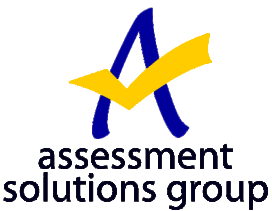One of the core strengths of the Assessment Solutions Group is its development of a comprehensive model on assessment costs by element/function. The model has more than one hundred variables, includes many specialized activities, and is built to compute program cost, component by component, from the ground up. That is, the costs for individual program elements are aggregated to determine overall program costs. The model starts with “test design” and goes through the processes of item development, composition, production and manufacturing, warehousing/shipping, psychometrics, scoring/editing/reporting, program management, quality assurance and information technology, in order to get the most accurate and detailed data on assessment costs.
The ASG Assessment Cost Model is a variable-input, metric-based output model. That is, specific assessment program variables are input to the model and applied against cost factors, metrics and/or databases to derive assessment cost. Several hundred variables associated with the functions and activities required to develop and administer an assessment are contained in the model which allows ASG to build up the cost of any assessment from the ground up as opposed to making generalized estimates of the cost of an assessment based on broad industry parameters. This means that the cost ASG calculates for each assessment design will be specifically related to the actual assessments that states could implement and will have a high degree of fidelity.
Based on our decades of experience in the assessment industry, ASG has developed “efficient cost metrics” for each key assessment cost area and function so that a state’s assessment program cost data can be compared to those of an “efficient” assessment. This allows states to see where their new assessment program is cost effective and where there might be opportunities to improve costs by changing various assessment program elements. We will use our model to work with clients to design efficient and effective assessment program designs thereby potentially saving states millions of dollars.
The model generates detailed cost information clients can use to evaluate assessment and assessment component cost. Cost reports by function, area, cost type etc. are generated and key metrics are presented to better understand assessment cost, as well as allowing for a comparison to model “efficient cost” data. Standard and custom reports are available at the summary and detail levels. The model was developed and programmed by ASG staff so changes can be easily made to accommodate the specifics of different assessment program designs. Data is presented in both report and graphical formats. Standard reports generated by ASG for state assessment programs include:
- Assessment Cost Summary
- Assessment Cost by Function
- Detail Assessment Functional Cost
- Fixed and Variable Cost Data
- Assessment Price Composition (direct, indirect, margin)
- Key Metrics Summary & Functional Area Metrics Summary
- Assessment Costs vs. “Efficient Costs”
- Assessment Metrics vs. “Efficient Metrics”
- Assessment Cost by Subject
- Assessment Cost by Grade
ASG maintains a series of databases and tables (over 70 in total) outside of the model so that cost rates and inputs can be continually updated as necessary to generate current cost data. Key databases include:
- Labor Cost By Region (by job classification)
- Shipping Rates
- Manufacturing Cost
- Travel Rates
- Open Ended Scoring Reader Rates
- Item Acquisition/Permission Rates
The ASG Assessment Cost Model has been tested against real industry data to verify the accuracy of its results. The cost model typically generates cost estimates within 10% of vendor bid costs when assumptions have not been synced up and within 5% of vendor costs when they have.
ASG is pleased to provide a demonstration of the costing model for clients via WebEx.
